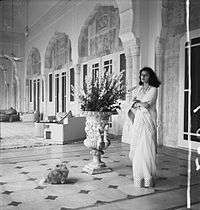Polygamy in India
Polygamy in India is outlawed. While polygamy was not prohibited in Ancient India and it was common among aristocrats and emperors, it is believed that it was not a major cultural practice. The lack of prohibition was in part due to the separation between land laws and religion (independence of the judiciary), and partially since all of the major religions of India portrayed polygamy in a neutral light.[1]

In contrast to Europe, polygamy prevailed in ancient India for rulers and kings.[2] It was common for rulers (for example Bhupinder Singh of Patiala and Fateh Singh of Udaipur and Mewar). Some wealthy individuals (for example Ramkrishna Dalmia, Gajanan Birla[3] and P. Rajagopal) had multiple wives.
The British colonial Empire of India permitted Islamic provinces to allow husbands to have multiple wives. When Maharaja Ranjit Singh was cremated in Lahore, four of his wives and seven concubines took to Sati,[4] and their urn-like memorials exist at his Samadhi.[5]
Legal developments
Section 494 and 495 of the Indian Penal Code of 1860, prohibited polygamy for the Christians. In 1955, the Hindu Marriage Act was drafted, which prohibited marriage of a Hindu whose spouse was still living. Thus polygamy became illegal in India in 1956, uniformly for all of its citizens except for Muslims, who are permitted to have four wives and for Hindus in Goa and along the western coast where bigamy is legal.
A polygamous Hindu marriage is null and void.[6] While the punishment specified in articles 494 and 495 is applicable, it is rare if the first spouse does not have an objection.
Muslim Polygamy
Muslims in the rest of the country are subject to the terms of The Muslim Personal Law (Shariat) Application Act of 1937, interpreted by the All India Muslim Personal Law Board.
However, in a judgment in February 2015, the Supreme court of India stated that "Polygamy was not an integral or fundamental part of the Muslim religion, and monogamy was a reform within the power of the State under Article 25".[7]
Hindu Polygamy in modern India
The Bollywood star and Lok Sabha member Dharmendra was already married to Prakash Kaur when he married actress Hema Malini in 1980. While it was reported that he had converted to Islam for the sake of the marriage,[8] he denied getting converted.[9]
Legally the second wife of a Hindu would be a mistress, although religiously and socially she may be considered a wife.
Polygamy among Hindus is sometimes accepted in some rural areas,[10] often with approval by earlier wives. The 2005-06 National Family Health Survey (NFHS-3) found that 2 percent of women reported that their husband had other wives besides herself. Husbands of women with no children are more likely to have multiple wives.[11]
Polyandry has been traditionally permitted in a few Hindu tribes.
Conversion for the purpose of Polygamous Marriage
There have been many instances in the past where Hindu men have converted to Islam to practice polygamy legally since polygamy is legal for Muslims in India.
Christian Polygamy
In Mizoram state, a Christian religious sect, called the "Pu Chana páwl" or just "Chana", formed in June 1942, practices polygamy. The founder Ziona, a 66-year-old man, has 39 wives, 94 children and 33 grandchildren, all living under one roof.[12]
See also
References
- "Polyandrous family customs in India". Drishtikone. Retrieved 16 May 2016.
- Polygamous Marriages in India, Vaidehi Yelamanchili, Sulabha Parasuraman, Population Association of America, 2010 Annual Meeting
- The Birlas: Empire in transition, T.N. Ninan, Chander Uday Singh, Sumanta Sen, India Today, 20 July 2013
- Samadhi of Ranjit Singh – a sight of religious harmony, Pakistan Today, JANUARY 16, 2016, NADEEM DAR
- ‘Sati’ choice before Maharaja Ranjit’s Ranis, Kanwarjit Singh Kang, 28 June 2015
- Modern Indian Family Law, Werner Menski, Routledge, 2013 p.194
- http://timesofindia.indiatimes.com/india/Polygamy-not-integral-part-of-Islam-SC/articleshow/46180105.cms
- Dharmendra or "Dilawar Khan?" Mili Gazette, 16-30 June 2004
- Two's A Crowd His marriages give the actor's campaign a rude jolt, K.S. SHAINI, KAPIL BHATT, Outlook 2004
- Some Indian men are marrying multiple wives to help beat drought, Mallika Kapur, CNN, 16 July 2015
- Polygamous Marriages in India
- Indian man with 39 wives, 94 children and 33 grandchildren, The Telegraph, 22 February 2011